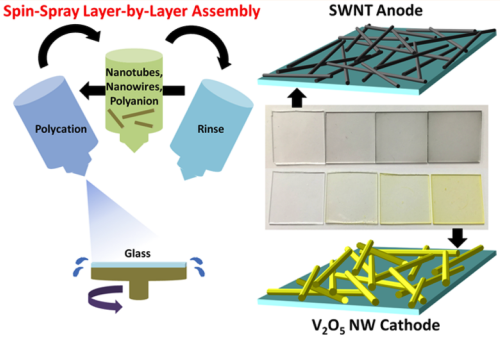
In a demonstration of the versatility of the spin-spray layer-by-layer technique, post-doc Forrest Gittleson and colleagues from the Taylor lab report the fabrication of transparent energy storage cells, using a combination of single-walled carbon nanotubes embedded in an anode and V2O5 nanowires comprising the cathode. Just as other studies have demonstrated the importance of high quality SWNT dispersions for layered deposition, Gittleson and co-workers dispersed the V2O5 nanowires in polyanionic solutions of polyacrylic acid (PAA). The demonstration of cell capacity over 100 charging cycles shows promise for transparent batteries for wearable devices, translucent electronics, and other new and emerging technologies. The study, published in ACS Nano, has been featured on InterNano.org, a project of the National Nanomanufacturing Network.
Ultrathin Nanotube/Nanowire Electrodes by Spin-Spray Layer-by-Layer Assembly: A Concept for Transparent Energy Storage
Forrest S. Gittleson, Daniel Hwang, Won-Hee Ryu, Sara M. Hashmi, Jonathan Hwang, Tenghooi Goh, and Andre´ D. Taylor
Abstract:
Fully integrated transparent devices require versatile architectures for energy storage, yet typical battery electrodes are thick (20-100 μm) and composed of optically absorbent materials. Reducing the length scale of active materials, assembling them with a controllable method and minimizing electrode thickness should bring transparent batteries closer to reality. In this work, the rapid and controllable spin-spray layer-by-layer (SSLbL) method is used to generate high quality networks of 1D nanomaterials: single-walled carbon nanotubes (SWNT) and vanadium pentoxide (V2O5) nanowires for anode and cathode electrodes, respectively. These ultrathin films, deposited with ~2 nm/bilayer precision are transparent when deposited on a transparent substrate (>87% transmittance) and electrochemically active in Li-ion cells. SSLbL-assembled ultrathin SWNT anodes and V2O5 cathodes exhibit reversible lithiation capacities of 23 and 7 μAh/cm2, respectively at a current density of 5 μA/cm2.When these electrodes are combined in a full cell, they retain ~5 μAh/cm2 capacity over 100 cycles, equivalent to the prelithiation capacity of the limiting V2O5 cathode. The SSLbL technique employed here to generate functional thin films is uniquely suited to the generation of transparent electrodes and offers a compelling path to realize the potential of fully integrated transparent devices.